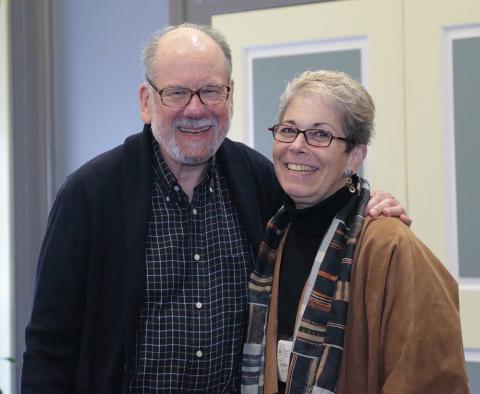NIDDK’s Rosner Ends Half-Century NIH Career

Photo: Bill Branson
Dr. Judah Leon “Lee” Rosner, a senior investigator in the molecular genetics section of NIDDK’s Laboratory of Molecular Biology, concluded a 50-year NIH career on Apr. 29 with an afternoon-long scientific seminar in Wilson Hall that featured his many collaborations and the breadth of his involvement with the NIH community.
Rosner was a Ph.D. student at Yale University, after having studied zoology as an undergraduate at Columbia College, when he was recruited to NIH in 1965 by Dr. Michael Yarmolinsky of the Laboratory of Molecular Biology (LMB). Two years later, he had earned his Yale degree and was well along in establishing the hallmarks of his NIH tenure—science, friendship, humor, service and social engagement.
Rosner, who will continue his work in Bldg. 5 as a special volunteer, is an all-access NIH’er. He wrote papers in his specialty of bacterial genetics with colleagues all over the world; he traveled extensively to recruit minorities to science careers at NIH; he helped lead an NIH committee that protested the Vietnam War (and invited prominent anti-war spokesman Dr. Benjamin Spock to speak at NIH); he gave his 100th blood donation at NIH in 1992, is now up to his 220th donation and still gives regularly; he supported NIH R&W activities generously, including long stints as a softball player in both the men’s league (Heartbreakers) and coed league (Cloneheads).
And he was a loyal member of the Lambda Lunch, perhaps NIH’s longest-running debate society/journal club. His retirement seminar included hallmarks of the LL—high-minded intellectual battle on the topic of “struggles for the soul of biology.”
Rosner, who studied lambda phage in E. coli, even drove a car with license plates that read “Eco Lee.”
NIDDK scientist emeritus Dr. Bob Martin said he and Rosner were “NIH’s odd couple.” They did science by day—publishing some 30 papers together—but also took bagel-making classes and learned Italian, among other adventures. “Lee trained as many people of color as the rest of NIH combined,” said Martin, adding that in the 1970s and 1980s, Rosner was one of few NIH’ers recruiting talent to NIH from historically black colleges and universities.
Martin encountered in Rosner a person “not satisfied until every nuance [of an intellectual argument] was analyzed from every angle…He is still brimming with scientific ideas and criticisms.” Lately, said Martin, Rosner has been advocating for first-aid courses to be taught in public schools.

Photo: Bill Branson
Dr. Michael Gottesman, NIH deputy director for intramural research, was a member of LMB from 1971 to 1974, and recalls that “Lee was the leader of the welcome wagon there.” The two published a paper in PNAS in 1975 describing the new transposon, Tn9. “I’m grateful to Lee for introducing me to the field [of antibiotic resistance].”
“Lee was one of the people in Bldg. 2 who made us feel at home,” said Gottesman’s wife, Dr. Susan Gottesman, who is co-chief of NCI’s LMB. As she and other scientists worked to unravel the complex set of transcriptional regulators that drive drug efflux pumps, “we knew that Lee was there to fall back on when we didn’t know what to do.”
Yarmolinsky, now an NCI scientist emeritus, credited Rosner with upholding standards of integrity in science, especially in an article Rosner published in Nature on May 10, 1990—“Reflections of science as a product.”
Rosner had examined the titles of papers in biology and chemistry from 1500 to 1989, discovering that, in about 1970, a pernicious trend began: AST, or assertive sentence titles. Science was becoming a product, not a process, he argued.
The habit of putting the conclusion in the title is “a perversion of the process” of science, argued Yarmolinsky. “It suggests that the story is told, not just well-begun…Impact is not to be confused with importance,” he said, decrying the rise of “impactitis.”
“I’m really overwhelmed,” said Rosner, at the seminar’s conclusion. He called himself a product of LMB and the Lambda Lunch. “Those two places taught me to cooperate, be friendly, share and struggle for the truth…It really does take a village” to produce a good scientist, he concluded. “I was surrounded by great scientists, great human beings and great friends.”
